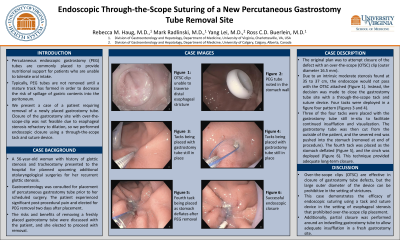Back


Poster Session D - Tuesday Morning
Category: Endoscopy Video Forum
D0191 - Endoscopic Through-the-Scope Suturing of a Percutaneous Gastrostomy Tube Removal Site
Tuesday, October 25, 2022
10:00 AM – 12:00 PM ET
Location: Crown Ballroom

Has Audio
.jpg)
Rebecca Haug, MD
University of Virginia
Charlottesville, VA
Presenting Author(s)
Rebecca Haug, MD1, Mark Radlinski, MD1, Yang Lei, MD1, Ross Buerlein, MD2
1University of Virginia, Charlottesville, VA; 2University of Virginia Digestive Health Center, Keswick, VA
Introduction: Percutaneous endoscopic gastrostomy (PEG) tubes are commonly placed to provide nutritional support for patients who are unable to tolerate oral intake. Typically, PEG tubes are not removed until a mature track has formed in order to decrease the risk of spillage of gastric contents into the peritoneum. We present a case of a patient requiring immediate removal of a newly placed gastrostomy tube. Closure of the gastrostomy site with over-the-scope-clip was not feasible due to esophageal stenosis refractory to dilation, so we performed endoscopic closure using a through-the-scope tack and suture device.
Case Description/Methods: A 56-year-old woman with history of glottic stenosis and tracheostomy presented to the hospital for planned upcoming additional otolaryngological surgeries for her recurrent glottic stenosis. Gastroenterology was consulted for placement of percutaneous gastrostomy tube prior to her scheduled surgery. The patient experienced significant post-procedural pain and elected for PEG removal two days after placement. The risks and benefits of removing a freshly placed gastrostomy tube were discussed with the patient, and she elected to proceed with removal. The original plan was to attempt closure of the defect with an over-the-scope (OTSC) clip (outer diameter 16.5 mm), however due to an intrinsic moderate stenosis found at 35 to 37 cm, the endoscope would not pass with the OTSC attached. Instead, the decision was made to close the gastrostomy tube site with a through-the-scope tack and suture device. Four tacks were deployed in a figure four pattern. Three of the four tacks were placed with the gastrostomy tube still in-situ to facilitate continued insufflation and visualization. The gastrostomy tube was then cut from the outside of the patient, and the severed end was pushed into the stomach. The fourth tack was placed as the stomach deflated, and the cinch was deployed with adequate long-term closure.
Discussion: Over-the-scope clips (OTSC) are effective in closure of gastrostomy tube defects, but the large outer diameter of the device can be prohibitive in the setting of strictures. This case demonstrates the efficacy of endoscopic suturing using a tack and suture device in the setting of esophageal stenosis that prohibited over-the-scope clip placement. Additionally, closure was performed around an indwelling gastrostomy tube to provide adequate insufflation in a fresh gastrostomy site.
Disclosures:
Rebecca Haug, MD1, Mark Radlinski, MD1, Yang Lei, MD1, Ross Buerlein, MD2. D0191 - Endoscopic Through-the-Scope Suturing of a Percutaneous Gastrostomy Tube Removal Site, ACG 2022 Annual Scientific Meeting Abstracts. Charlotte, NC: American College of Gastroenterology.
1University of Virginia, Charlottesville, VA; 2University of Virginia Digestive Health Center, Keswick, VA
Introduction: Percutaneous endoscopic gastrostomy (PEG) tubes are commonly placed to provide nutritional support for patients who are unable to tolerate oral intake. Typically, PEG tubes are not removed until a mature track has formed in order to decrease the risk of spillage of gastric contents into the peritoneum. We present a case of a patient requiring immediate removal of a newly placed gastrostomy tube. Closure of the gastrostomy site with over-the-scope-clip was not feasible due to esophageal stenosis refractory to dilation, so we performed endoscopic closure using a through-the-scope tack and suture device.
Case Description/Methods: A 56-year-old woman with history of glottic stenosis and tracheostomy presented to the hospital for planned upcoming additional otolaryngological surgeries for her recurrent glottic stenosis. Gastroenterology was consulted for placement of percutaneous gastrostomy tube prior to her scheduled surgery. The patient experienced significant post-procedural pain and elected for PEG removal two days after placement. The risks and benefits of removing a freshly placed gastrostomy tube were discussed with the patient, and she elected to proceed with removal. The original plan was to attempt closure of the defect with an over-the-scope (OTSC) clip (outer diameter 16.5 mm), however due to an intrinsic moderate stenosis found at 35 to 37 cm, the endoscope would not pass with the OTSC attached. Instead, the decision was made to close the gastrostomy tube site with a through-the-scope tack and suture device. Four tacks were deployed in a figure four pattern. Three of the four tacks were placed with the gastrostomy tube still in-situ to facilitate continued insufflation and visualization. The gastrostomy tube was then cut from the outside of the patient, and the severed end was pushed into the stomach. The fourth tack was placed as the stomach deflated, and the cinch was deployed with adequate long-term closure.
Discussion: Over-the-scope clips (OTSC) are effective in closure of gastrostomy tube defects, but the large outer diameter of the device can be prohibitive in the setting of strictures. This case demonstrates the efficacy of endoscopic suturing using a tack and suture device in the setting of esophageal stenosis that prohibited over-the-scope clip placement. Additionally, closure was performed around an indwelling gastrostomy tube to provide adequate insufflation in a fresh gastrostomy site.
Disclosures:
Rebecca Haug indicated no relevant financial relationships.
Mark Radlinski indicated no relevant financial relationships.
Yang Lei indicated no relevant financial relationships.
Ross Buerlein indicated no relevant financial relationships.
Rebecca Haug, MD1, Mark Radlinski, MD1, Yang Lei, MD1, Ross Buerlein, MD2. D0191 - Endoscopic Through-the-Scope Suturing of a Percutaneous Gastrostomy Tube Removal Site, ACG 2022 Annual Scientific Meeting Abstracts. Charlotte, NC: American College of Gastroenterology.
